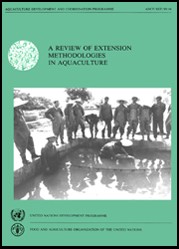
AQUACULTURE DEVELOPMENT AND COORDINATION PROGRAMME
A REVIEW OF EXTENSION METHODOLOGIES IN AQUACULTURE
by
Carole R. Engle and Nathan M. Stone
UNITED NATIONS DEVELOPMENT PROGRAMME
FOOD AND AGRICULTURE ORGANIZATION OF THE UNITED NATIONS
Rome, 1989
|
The designations employed and the presentation of material in this publication do not imply the expression of any opinion whatsoever on the part of the Food and Agriculture Organization of the United Nations concerning the legal status of any country, territory, city or area or of its authorities, or concerning the delimitation of its frontiers or boundaries. |
All rights reserved. No part of this publication may be reproduced, stored in a retrieval system, or transmitted in any form or by any means, electronic, mechanical, photocopying or otherwise, without the prior permission of the copyright owner. Applications for such permission, with a statement of the purpose and extent of the reproduction, should be addressed to the Director, Publications Division, Food and Agriculture Organization of the United Nations, Via delle Terme di Caracalla, 00100 Rome, Italy.
© FAO 1990
This electronic document has been scanned using optical character recognition (OCR) software and careful manual recorrection. Even if the quality of digitalisation is high, the FAO declines all responsibility for any discrepancies that may exist between the present document and its original printed version.
1.1 The Role and Purpose of Extension in Aquaculture
1.2 The Role of Government Policy in Development of Extension Methodologies
2.1 Private Producers
2.2 Cooperatives
2.3 Subsistence Producers
2.4 Selection of Target Groups
3. RESPONSIBILITIES ASSUMED BY EXTENSION PERSONNEL
3.1 Education
3.2 Diagnostic Services
3.3 Supply of Production Inputs
3.4 Product Promotion
3.5 Enforcing Regulations
3.6 Advantages and Disadvantages of Different Extension Responsibilities
4.1 Centralized Versus Decentralized Control Over Extension Activities
4.2 Direction of Information Flow
4.3 Appropriate Extension Strategies
4.4 Case Studies
4.4.1 General considerations for aquaculture development in Africa and Latin America
4.4.2 Rwanda
4.4.3 Zaïre
4.4.4 Liberia
4.4.5 Panama
5.1 Selection of Extension Agents
5.2 Specific Techniques of Extension
6. ORGANIZATIONAL STRUCTURE OF EXTENSION SERVICE
6.1 Extension Roles of Different Institutions
6.2 Linkages Between Extension and Research Efforts
7. RECOMMENDATIONS FOR DEVELOPING AND STRENGTHENING AQUACULTURE EXTENSION PROGRAMMES
ANNEX I - SURVEY INSTRUMENT OF EXTENSION METHODOLOGIES
ANNEX II - ORGANIZATIONAL CHARTS OF AQUACULTURE EXTENSION SERVICES
ANNEX III - ABBREVIATIONS